The Genesis is home to a wide variety of titles, some better than others. Among the cornucopia of games, there are some interesting stories to be told. As we unravel the true history of the console, we discover exactly what went into making some of our favorite titles.
Some o f the more interesting testimonials we’ve heard so far have come from Scott Berfield, a former producer at Sega of America. Currently the Account Manager for Developer Relations at Microsoft, Mr. Berfield is playing a big role in making Xbox Live Arcade one of the premier attractions of Microsoft’s online service. At Sega, he oversaw some of the companies best-selling titles, like Eternal Champions, Joe Montana Sports Talk Football, and ToeJam & Earl. Producing titles that combined to sell well over two million units was a pretty mean feat at the time, but it wasn’t all an easy ride. Several titles had some major hurdles to overcome, and a few sadly never made it market.
f the more interesting testimonials we’ve heard so far have come from Scott Berfield, a former producer at Sega of America. Currently the Account Manager for Developer Relations at Microsoft, Mr. Berfield is playing a big role in making Xbox Live Arcade one of the premier attractions of Microsoft’s online service. At Sega, he oversaw some of the companies best-selling titles, like Eternal Champions, Joe Montana Sports Talk Football, and ToeJam & Earl. Producing titles that combined to sell well over two million units was a pretty mean feat at the time, but it wasn’t all an easy ride. Several titles had some major hurdles to overcome, and a few sadly never made it market.
Mr. Berfield spoke to us about his time at Sega and had some interesting things to say about his experiences there.
Sega-16: How exactly did you get your start at Sega?
Scott Berfield: I moved to California in 1989 to work as a producer on the Infocom product line at Mediagenic (what Activision was calling itself in those days). As soon as I got there it was clear that the company was in serious trouble and I started looking around. Sega was just ramping up in the US so I sent a resume but never heard back. I was at CES in Las Vegas in January of 1990 when I saw Michael Katz, the then president of Sega of America, standing next to a “We Are Hiring” sign. I told him I was pretty disappointed in the fact that I didn’t get any response – not even a polite “go away” form his HR department and he asked me for a copy of my resume. They called a few weeks later and after a bunch of interviews we arranged for me to come work for them. My last day at Mediagenic, I worked until noon, drove to the San Francisco airport and flew to Chicago where I started working for Sega at CES that afternoon.
Sega-16: You produced a few titles that featured the names of famous athletes like Joe Montana and Evander Holyfield. What level of involvement did they have in the games they endorsed? Were they actively involved or did they treat the projects as just another endorsement?
Scott Berfield: They were not very heavily involved in the game development or design, though they had sign-off rights to everything. Both Joe and Evander were really nice people though. We worked with Evander at CES to promote the game and he was really fun to hang out with. Joe was also a really nice guy. When we shot a TV commercial with him he took time to meet everyone and sign footballs (still have mine) and even threw the ball around with us in between shots. A totally gracious and gentle man.
Sega-16: One game you were working on, Savage Heroes, was never released. Why not? What was the game like?
Scott: Berfield: Savage Heroes was a game I started designing when I went to EA in 1993. I love fighting games and one of my favorite Genesis games was Streets of Rage (a game I helped tune up for the American audience). I decided we needed to do a game that combined a brawler like SOR with one-on-one fighting like Street Fighter II. The ideas was that it was another world populated exclusively with humanoid intelligent animals. There was a team of four heroes that worked together to fight crime. There was (excuse the stupid names — I was a lot younger then) Bruno, a kung-fu master bear and leader of the group, Lucy, a kick-boxing she-wolf, Reno the massive rhinoceros brawler, and Leon a street-smart karate expert lion. They were going up against the crime boss Teeg, a Bengal Tiger. The user would use different characters depending on the part of the story they were in at the time, and it would have supported two-player play. Combat would use a streamlined version of the SFII controls for street fights, and when a boss came up, the game would switch to a closer up arena view and the controls would become more subtle to allow for SFII style fighting. We were also going to include a pure one-on-one fighting mode. The levels were all going to be seamlessly connected, so at the end of level one you might fall through a big skylight and as we saw you fall surrounded by shards of glass, the level wrap-up stats would display. Then when you pressed start, you would land in the next level in a shower of glass.
Graphically, we intended to use stop-motion figures and do frame by frame animations to get a photo-realistic look (as much as possible with the pretty terrible graphics hardware in the Genesis). We went so far as to have a dozen or so of the 12-16″ high fully articulated models made by a special effects shop in Texas. As far as I know these are all still in storage at EA somewhere — and I would KILL to have even one of them. These figures have machined metal skeletons covered in cast latex and real clothes.
There was a lot of enthusiasm for the game internally, but we ran into several issues that lead to the game’s demise. 1) It was a very ambitious idea that really should have been on a more powerful platform, 2) the developer we used for the prototype just wasn’t very good. When the prototype wasn’t very good, enthusiasm started to fade. At EA, your projects lived or died based on reviews that used sales forecasts as input. If you lost internal momentum, you were dead. The project was finally dead on Genesis when all of our marketing support got pulled to put on Shaq-Fu (sigh). We shelved the game and intended to re-visit it on PlayStation or some other advanced system.
Sega-16: Art Alive is supposedly compatible with the Mega Mouse. Can you confirm this?
Scott Berfield: We built in support, but had no way to test it since the mouse wasn’t really available. It might work, but I couldn’t guarantee it.
Sega-16: Many people enjoyed Art Alive but were left wanting more. Was a sequel ever planned?
Scott Berfield: Not really. That product was done in a VERY short time period with a minimal budget to fulfill some requirement management had (I don’t recall why we did it) and it had to fit in a tiny cartridge. There was a lot more I wanted to do with it — but I consider it a triumph that it got done at all.
Sega-16: You created the concept and initial character designs for Eternal Champions. What did you think of the final product?
Scott Berfield: It was boring. The art was boring and the controls sloppy. It felt like it was developed by people who had never played a fighting game in their lives. The product that shipped had only three things in common with the original concept as approved: 1) it was a fighting game, 2) it had the same name, and 3) Shadow, the female assassin was in the original concept and the final product.
The original idea was to go way over the top and make a really crude, funny, and artistically striking game with really tight controls (basically ripping off SFII‘s control scheme). The characters were all designed after an artist named Simon Bisley. I tried to get Simon to do the art, but he was booked for more than a year doing comics and couldn’t do it. The characters were supposed to be larger than life heroic types – but with humor. For example the barbarian fighter had flies buzzing around him all the time and his idle animations included scratching inappropriately. We also were going to have mini-games for training your characters. These were all very silly and based on abusing dwarves (not human dwarves, these were nasty brutish fantasy story dwarves). We were going to have bungee dwarves with knives, dwarf batting, etc… Imagine the X-Men Danger Room with dwarves… with knives.
Basically, the game that shipped sucked all the flavor out of the game concept, and while they did some sort of innovative control things, the execution was sloppy. The CD version was improved, but I think they made a pretty blah product.
Sega-16: Former Sega producer Mike Latham mentioned that he received the project from “another producer.” Would that be you?
Scott Berfield: Yes. I wrote the initial concept and designed the characters. We put together a 10-15 page summary doc with character sketches (which I also wish I still had) and I used that to get the project greenlit. It was hard because no one believed a U.S. company could make a fighting game.
Sega-16: Joe Montana’s Sports Talk Football was the first console game with play-by-play commentary, something quite impressive given the sound issues with the Genesis hardware. What was the biggest hurdle in getting all that speech into the game?
Scott Berfield: Getting all that speech into the game! Lol. Actually we took a sort of unique — but risky — approach. BlueSky in San Diego developed the football game. Western Technologies (in some town north of there) did the speech. A third company did the compression of the speech. This made for some pretty hairy logistics. We gave each company half of the eight megabit (one Megabyte) cart to use for their part of the game.
Western tech had already done speech for some dedicated game systems and they had algorithms for doing prosody and blending that sounded pretty darn good for the time. The announcer we used was chosen because his voice compressed well and because they had worked with him before. BlueSky was a fairly new developer that I had worked with on some other stuff, and they were desperate to do a football game, being huge fans.
From a technical point of view, the hardest thing about it all was the fact that in the Genesis, there is no hardware sync between CPU and audio. The audio chip in the Genesis is actually a Z80 processor. There is a pin that would allow the 68000 and Z80 to stay in sync, but it is not connected. So the CPU actually has no way to know for sure when a speech state is completed. This was a major headache.
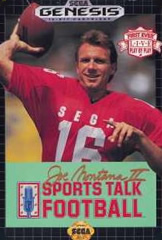 We ran into one great hiccup towards the end. We were final and almost ready to submit the ROMs to Japan for duplication and a tester found a hard-lock bug. Through really hard work, the tester figured out that if the center got the ball, the game would crash. I called BlueSky and told them about it and their response was “the center can’t GET the ball”. I pointed out that the center COULD get the ball and that my wizard tester could do it (with difficulty) repeatedly. They said they’d call me back. They called back and said “OK, if the center gets the ball, it shouldn’t crash – all we do is call speech state 0 (the center is player 0), and then the game runs as normal.” Hmm… So I called Western tech and asked what happens when the game engine calls speech state 0. Their response was “There IS no speech state 0. The speech states are numbered from 1 to 255.” Uh-oh. It turns out that the game coders had their array of players numbered from 0 to some number, like one would do using C. The Speech guys had their speech states numbered from 1-255, like you would do using a language like Pascal. Call the nonexistent state and BOOM. Anyway, we got it fixed and sent off by the next day, but it sure threw a wrench in things for a while.
We ran into one great hiccup towards the end. We were final and almost ready to submit the ROMs to Japan for duplication and a tester found a hard-lock bug. Through really hard work, the tester figured out that if the center got the ball, the game would crash. I called BlueSky and told them about it and their response was “the center can’t GET the ball”. I pointed out that the center COULD get the ball and that my wizard tester could do it (with difficulty) repeatedly. They said they’d call me back. They called back and said “OK, if the center gets the ball, it shouldn’t crash – all we do is call speech state 0 (the center is player 0), and then the game runs as normal.” Hmm… So I called Western tech and asked what happens when the game engine calls speech state 0. Their response was “There IS no speech state 0. The speech states are numbered from 1 to 255.” Uh-oh. It turns out that the game coders had their array of players numbered from 0 to some number, like one would do using C. The Speech guys had their speech states numbered from 1-255, like you would do using a language like Pascal. Call the nonexistent state and BOOM. Anyway, we got it fixed and sent off by the next day, but it sure threw a wrench in things for a while.
Sega-16: You left Sega while several projects were still in development, like Shadowrun an Eternal Champions. Why did you leave?
Scott Berfield: There were some personal reasons plus I felt like I wasn’t learning or doing anything new. I also had an issue with the management of the group. I had a chance to go to EA — the best company in the business back then — so I took it.
Sega-16: Strike series designer Mike Posehn said he sometimes thinks about doing another installment but doesn’t like the massive development team environment common in the gaming industry today. Many people today seem to share his opinion that the industry is becoming too big to retain the creativity necessary to make great games. Would you agree?
Scott Berfield: I don’t think creativity goes away when you have a large team. It just takes a different sort of skill to bring it out. Many people can’t function in a big group, but a strong vision clearly communicated will still win over a team. The bigger issue with the huge teams and high costs is the risk aversion it engenders in publishers. If a game costs $20MM and 3 years to develop, that is a very different risk calculus than if it costs $200K and takes 9 months. I think some of the new things happening in casual and downloadable games are very promising for smaller groups or even individual devs and will probably lead to some really creative stuff. We have long needed a way to get indie content to the world; it happens on PCs, but it is a lot harder on consoles. I think Xbox Live Arcade (shameless plug) has potential to make some changes here, and Sony is also making noise in the area of electronic distribution of smaller games.
Sega-16: Microsoft is set to bring back Shadowrun, ToeJam & Earl recently returned on the Xbox, and Afterburner is appearing on Sega’s new Lindbergh hardware. If given the chance, would you be interested in working on a new Eternal Champions?
Scott Berfield: I would love to. I still think the original story, characters and style would make a really fun product. I would be even more interested in trying to make Savage Heroes happen, as I still have a soft spot for those characters.
We enjoyed talking to Mr. Berfield and thank him for his time.

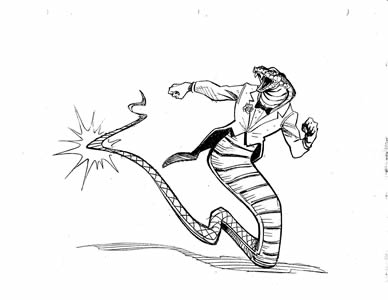
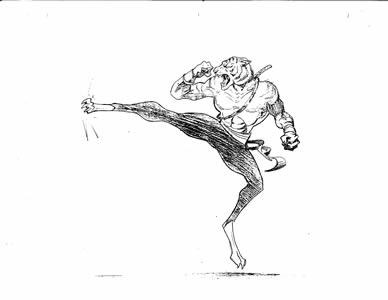
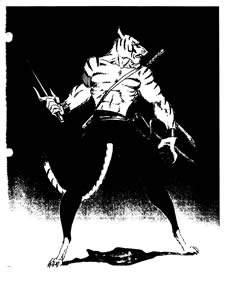
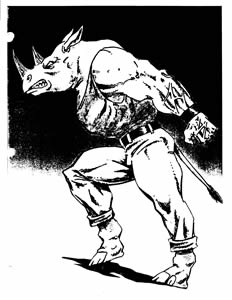
Pingback: Shaq Fu | Bad Game Hall of Fame
Pingback: Eternal Champions: Quando a Sega perdeu a chance de criar seu clássico da porrada - Jogos de Porrada